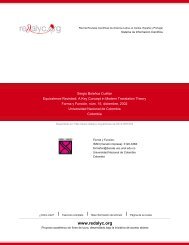Portraits of the spiritual Seeing in Mark's Gospel. Origen ... - Redalyc
Portraits of the spiritual Seeing in Mark's Gospel. Origen ... - Redalyc
Portraits of the spiritual Seeing in Mark's Gospel. Origen ... - Redalyc
You also want an ePaper? Increase the reach of your titles
YUMPU automatically turns print PDFs into web optimized ePapers that Google loves.
Jesus and <strong>the</strong> Demons:...<br />
319<br />
Jesus appears as <strong>the</strong> explicit subject <strong>of</strong> <strong>the</strong> verb eiden. The object <strong>of</strong><br />
his vision is dual: a) <strong>the</strong> heavens torn open (schizoménous toús ouranoùs<br />
1:10 a ) and b) <strong>the</strong> Spirit descend<strong>in</strong>g upon him like a dove (1:10 b ). This<br />
means that <strong>the</strong> first eyesight <strong>of</strong> Jesus is marked by <strong>the</strong> vision <strong>of</strong> a non<br />
terrestrial reality. The beg<strong>in</strong>n<strong>in</strong>g <strong>of</strong> his public m<strong>in</strong>istry starts with <strong>the</strong><br />
exclusive div<strong>in</strong>e manifestation that reveals <strong>the</strong> Lord’s po<strong>in</strong>t <strong>of</strong> <strong>in</strong>terest:<br />
to look up to heaven, his Fa<strong>the</strong>r’s place, and see <strong>the</strong> Holy Spirit com<strong>in</strong>g<br />
down to his own reality, namely, <strong>the</strong> one that implies to be human. Thus<br />
<strong>the</strong> first see<strong>in</strong>g <strong>of</strong> Jesus is meta-physical 23 <strong>in</strong> <strong>the</strong> sense that his visual<br />
perception goes beyond or beh<strong>in</strong>d <strong>the</strong> physical reality that is commonly<br />
see<strong>in</strong>g by <strong>the</strong> bodily sense <strong>of</strong> sight. The meta-physical see<strong>in</strong>g trespasses<br />
<strong>the</strong> barrier <strong>of</strong> <strong>the</strong> corporeal limitations <strong>in</strong> order to see a <strong>spiritual</strong> reality<br />
that is not obvious to <strong>the</strong> naked corporeal eye, but is typical <strong>of</strong> Jesus’<br />
see<strong>in</strong>g. At <strong>the</strong> same time his visual experience is exclusive because <strong>the</strong><br />
text <strong>of</strong> Mark 1:9-11 <strong>in</strong>dicates that only Jesus was capable <strong>of</strong> see<strong>in</strong>g this<br />
dual celestial reality; <strong>the</strong> context does not <strong>in</strong>dicate that o<strong>the</strong>r person<br />
could perceive <strong>the</strong> celestial phenomenon.<br />
The synoptic read<strong>in</strong>g <strong>of</strong> this episode highlights <strong>the</strong> dist<strong>in</strong>ctiveness<br />
<strong>of</strong> Jesus’ see<strong>in</strong>g <strong>in</strong> Mark. A parallel analysis reveals that Mat<strong>the</strong>w 3:16<br />
<strong>in</strong>dicates that <strong>the</strong> open<strong>in</strong>g <strong>of</strong> <strong>the</strong> heavens is not related to Jesus’ see<strong>in</strong>g,<br />
just only <strong>the</strong> Spirit <strong>of</strong> God like a dove descend<strong>in</strong>g on him. Mat<strong>the</strong>w<br />
specifies that is <strong>the</strong> Spirit <strong>of</strong> God (tó pneūma toū Theoū), while Mark<br />
mentions only <strong>the</strong> Spirit (tó pneūma). The heavenly voice accompany<strong>in</strong>g<br />
<strong>the</strong> celestial vision <strong>in</strong> Mark addresses exclusively to Jesus (Mark 1:11),<br />
unlike <strong>in</strong> Mat<strong>the</strong>w where <strong>the</strong> voice speaks to o<strong>the</strong>rs, <strong>in</strong>dicat<strong>in</strong>g an<br />
implicit audience (Matt 3:17). The strik<strong>in</strong>g difference can be noticed<br />
<strong>in</strong> Luke 3:22, where <strong>the</strong> author does not make any reference to Jesus’<br />
see<strong>in</strong>g. Extend<strong>in</strong>g <strong>the</strong> comparison to John 1:32-34, <strong>the</strong> reader realizes<br />
that <strong>the</strong> one who sees <strong>the</strong> Spirit is John <strong>the</strong> Baptist, meanwhile Jesus is<br />
passive <strong>in</strong> <strong>the</strong> scene. The results <strong>of</strong> this brief synoptic read<strong>in</strong>gs and <strong>the</strong><br />
23<br />
The expression «meta-physical see<strong>in</strong>g» derives from <strong>the</strong> literal etymological<br />
comb<strong>in</strong>ation <strong>of</strong> two Greek terms: metá, a preposition that has, among many o<strong>the</strong>r<br />
renditions, <strong>the</strong> significance <strong>of</strong> «beyond, upon, after, beh<strong>in</strong>d», frequent connotation<br />
<strong>in</strong> <strong>the</strong> Homeric style, and <strong>the</strong> substantive physis which signifies «nature, natural<br />
endowment or condition», imply<strong>in</strong>g <strong>the</strong> naturally regulated order <strong>of</strong> th<strong>in</strong>gs <strong>of</strong> <strong>the</strong><br />
world that can be seen, this means <strong>the</strong> physical reality that is commonly perceived<br />
by <strong>the</strong> natural senses <strong>of</strong> perception. Cf. W. Bauer, W.F. Arndt, F.W. G<strong>in</strong>grich<br />
and F.W. Danker, Greek-English Lexicon… , 508. 869-870.
















